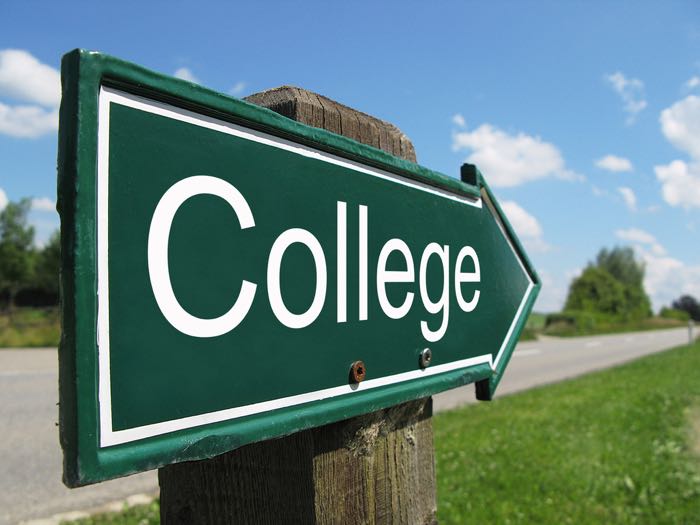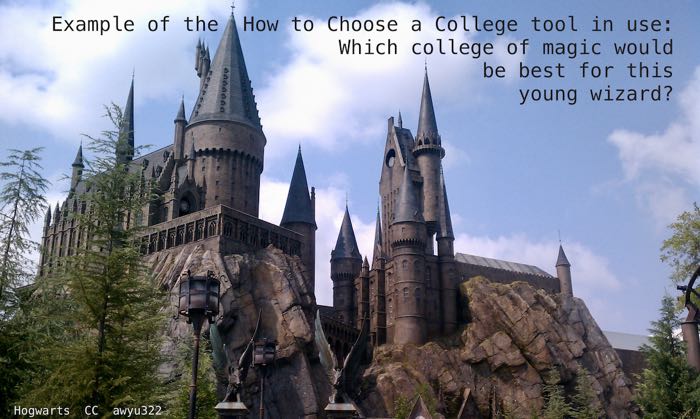How to Choose a College

The road to choosing a college
Let's assume that you're a solid student in high school. You've decided you want to go to a selective college, where the students and teachers will be amazing and the program will suit you. Where should you apply? If you are fortunate enough to be accepted at more than one college, how do you choose among them?
Ed100 offers a tool to help students make thoughtful choices about college.
This post equips you with some tools to take the mystery out of the college decisions you need to make.
What's your "why" for spending all this money?
Before we go there (and we will), let's take a step back. There are many good reasons to go to college, and getting into a selective college is a fine thing to want. But it's also smart to go in with your eyes open and your bank statement in plain view.
Working your way through college in four years directly out of high school used to be difficult, but achievable. Today it is mathematically impossible. Many students who begin college find that they cannot afford to finish it.
According to Ben Casselman, former senior editor and chief economics writer of 538.com, "Nearly one in five Americans age 25 to 34 has some college credits but no degree, and a growing share of them have student debt." Aggregate college debt in America is more than $1.7 trillion, a sum even larger than credit card debt.
America's famous selective colleges are primarily colleges for the rich. But some colleges are an engine for social mobility.
America's most famous colleges — the ones that routinely show up on "best college" rankings — are primarily colleges for the rich: they enroll more students from families in the top 1% of the nation's income distribution than they do from the bottom 60%. About 40% of children from America's richest families attend an Ivy League or other "elite" college. Students who attend these schools tend to do very well in life, and for students from families of modest means a diploma from an elite college can change everything. But the number of seats available in these schools is tiny, and fairly fixed. Over time the number of candidates for these seats has grown, making elite colleges much more selective than they were a generation ago.
Casselman cautions that the college experiences depicted in movies and media misrepresent reality for most students. For example, he points out that most colleges aren't particularly selective:
"According to data from the Department of Education, more than three-quarters of U.S. undergraduates attend colleges that accept at least half their applicants; just 4 percent attend schools that accept 25 percent or less, and hardly any — well under 1 percent — attend schools like Harvard and Yale that accept less than 10 percent."
College can be an engine for social mobility, and some schools are particularly notable for being the launching pad for the American dream, especially in California. But most of these launching pad colleges are on a different list than the elite schools.
California's college system
Your highest degree counts most on your resume.
Students in California are fortunate to have access to a strong three-tiered system of relatively affordable public colleges and universities, thanks to the Master Plan for higher education established in the state more than half a century ago. Many students in California begin their education in the affordable Community College system, then (with difficulty, unfortunately) transfer into the California State University, the University of California or elsewhere.
From a career perspective, the school where you earn your highest degree is the one most noticed on your resume. Barack Obama is known as a Harvard graduate, but he started college at Occidental, a highly selective private college in southern California.
Do colleges want you?
Whenever a teacher assigns a major project, the process begins with a rubric — a scorecard that breaks the work into parts. To earn a top grade, you have to do well on every part, but not all parts are of equal value. The rubric helps students know what counts, so they can manage their time and invest their energy where it will count. The rubric also helps teachers evaluate work and assign a grade.
Colleges look at your application through the lens of what they need.
College admissions officers have a certain number of seats they need to fill. Using their own rubrics, they plow through piles of applications, scoring quickly as they go to find the students they need. Rubrics differ from school to school and department to department, of course, but the big categories aren't rocket science:
Their rubric, simplified: How colleges will judge you. |
|---|
| Are you qualified to apply? The minimum academic bar for most four-year colleges in California is the a-g requirements, a set of courses you must pass before graduation with a C or better before you can earn college credits. But colleges can set their own requirements. |
| Will you succeed academically? Admissions officers at competitive schools can predict whether you will be academically successful in college pretty reliably by looking at high school transcripts and (in schools that use them) ACT or SAT scores. (Open link for a comparison. ACT also provides a concordance table.). Students who are underprepared might fail, which reflects badly on the school. The best things you can do to expand your college choices are to earn good grades in tough courses and earn high scores on standardized tests. |
| Will you add to the student body in a way that the the school wants? The admissions office plays an important role in building and balancing the student body. Even elite colleges don't only want rich prep school kids. They look out for diversity. Students who have overcome obstacles can be fantastic contributors to a college community, and many colleges look for them specifically. They also try to fill all sorts of specific needs: If a college is building a music department, they need cellists and bassoonists. If they have major athletic programs, they need skilled athletes. If they want lots of vibrant extracurricular groups, they need leaders. Colleges look at your application through the lens of what they need, not what you need. |
| Yield: Will you choose to attend, if offered a spot? College admissions teams want to extend offers that will be accepted. If they think you will decline their offer, they have an incentive to reject you, even if they think you're great. This is serious stuff. For colleges, yield (the percentage of accepted students that go on to enroll) has become a key factor in school rankings. Admissions teams are increasingly sophisticated about this. They score students' likelihood to choose their school based on measurable signals of "demonstrated interest": Did you show specific, informed interest in your essay? Have you opened emails they sent you? (Yes, of course they know and care.) Did you visit the school and take a tour? Did you show up to an event? Do you have some kind of connection to the school? |
What do you want, student?
Your own rubric can help you make a good college choice. Build it using the free Ed100 college choice tool.
What might be less obvious in this process is that you need a rubric, too. How do you think it through, guide your college search, and make a good choice?
To evaluate whether one college will be better for you than another, you need to know about the colleges, but you also need to know what matters to you.
100 Pennies. Suppose you had 100 pennies to represent what matters to you, broadly, in choosing a school.

Take those pennies and divide them into only the following piles, representing your best guess about what matters to you in a college:
- Academics
- Access to Family
- The College Experience
- Career Success
- Affordability
These aren't the only considerations, by a long shot. To really think it through you need to take it up a notch.
Choose your Decision Factors. The next step, as you learn about colleges, is to get more specific about the factors that matter to you and that will drive your decisions. Open the Ed100 How to Choose a College tool. It's a free tool built as a Google Spreadsheet.
After reviewing the instructions, start with the Interview tab in the sheet, maybe working with a parent, friend or adviser. It's meant to be a little like having a college counselor guiding you and asking the questions that actually matter. If you follow the instructions, you'll build your own personal rubric to help you make an informed decision. You'll also have some helpful guidance about what to ask as you investigate college options.
Review and rate schools. Once you have used the Interview tab to define your decision factors, the Ed100 How to Choose a College tool gives you a scorecard to evaluate each school you research (or, ideally, visit). If you use this tool along with a Fiske Guide or equivalent, you will generate a list of schools stack-ranked on your own terms. You'll also have a big leg up on writing your applications.
There are others college selection tools worth knowing about. For example, in 2023 the New York Times created a "Build your own college ranking" tool for paid subscribers. Others like the College Board and Princeton Review have tools, too.
Make choices. You can't apply to a zillion schools, and you shouldn't limit yourself to schools your neighbor's uncle has heard of. Do actual research! There are more great, selective colleges than you know about, especially smaller ones that don't spend gobs of money on advertising. (Ever heard of Carleton College, for example? I hadn't, but after visiting my son picked it over better-advertised selective schools. He got a really great education there, found new interests and really loved the professors.)
You will probably want to apply to a number of schools, including some that are a "stretch," some that are a reasonable "target" match, and some where you are "likely" to get in. (Some schools are so selective that many college counselors call them "lottery" schools!) As you review schools using the Ed100 How to Choose a College tool you can identify your likelihood of getting into each one.
Oh, yeah… the money. By identifying, researching and ranking schools in each likelihood tier, you will have a basis for making choices among them with money in the equation. If you are a very strong student with a compelling story, don't automatically write off those super-selective colleges. Financial aid exists. If a college decides they really want you, they may offer scholarships or find ways to help.
The essential trick to improve your odds: Early Decision
Many selective colleges allow students to apply on an "Early Decision" (ED) basis. You need to understand why they do this, and what it means for you. ED isn't just about sending your application in early, which is called "Early Action" (EA). It's a contract. You may only apply to ONE school for early decision, so if you use Early Decision you'd better be thoroughly sure of your choice. If you are accepted, that's it. You go.
At many schools, committing to Early Decision can massively boost your odds. There's a catch...
Schools like to admit qualified students through Early Decision, because every student they admit in this way is a sure bet. Did you read the part about "yield"? A high yield score serves as evidence that students really want to attend a college, which boosts the college's standing in college reviews. At many highly selective schools, applying ED can vastly boost your odds of being admitted.
But this isn't true of all schools. The percentage of the freshman class admitted early varies greatly from one college to another. Data collected by the College Data Set consortium shows that many schools fill more than half of their seats early. It is really important for students to understand how this works in the colleges they apply to — it can be the difference between getting in and having no chance at all. (Follow the link to see data for each college.)
Colleges share with one another the names of the students they admit via Early Decision. This cooperation (or perhaps collusion) is apparently not illegal, at least not yet. It certainly serves the interest of colleges by helping them avoid extending wasted offers that would reduce their yield.
There's a very important catch. The Early Decision system is likely to your advantage if are able to pay full tuition. But if you can't, applying Early Decision can put you in a crummy negotiating position for financial aid aid. You more or less have to accept whatever the school offers or walk away.
As you do your research, the Ed100 How to Choose a College tool provides space for you to take notes on each school's financial aid policies and the percentage of students admitted via early decision.
Updated June 2024.
Tags on this post
CollegeAll Tags
A-G requirements Absences Accountability Accreditation Achievement gap Administrators After school Algebra API Arts Assessment At-risk students Attendance Beacon links Bilingual education Bonds Brain Brown Act Budgets Bullying Burbank Business Career Carol Dweck Categorical funds Catholic schools Certification CHAMP Change Character Education Chart Charter schools Civics Class size CMOs Collective bargaining College Common core Community schools Contest Continuous Improvement Cost of education Counselors Creativity Crossword CSBA CTA Dashboard Data Dialogue District boundaries Districts Diversity Drawing DREAM Act Dyslexia EACH Early childhood Economic growth EdPrezi EdSource EdTech Education foundations Effort Election English learners Equity ESSA Ethnic studies Ethnic studies Evaluation rubric Expanded Learning Facilities Fake News Federal Federal policy Funding Gifted Graduation rates Grit Health Help Wanted History Home schools Homeless students Homework Hours of opportunity Humanities Independence Day Indignation Infrastructure Initiatives International Jargon Khan Academy Kindergarten LCAP LCFF Leaderboard Leadership Learning Litigation Lobbyists Local control Local funding Local governance Lottery Magnet schools Map Math Media Mental Health Mindfulness Mindset Myth Myths NAEP National comparisons NCLB Nutrition Pandemic Parcel taxes Parent Engagement Parent Leader Guide Parents peanut butter Pedagogy Pensions personalized Philanthropy PISA Planning Policy Politics population Poverty Preschool Prezi Private schools Prize Project-based learning Prop 13 Prop 98 Property taxes PTA Purpose of education puzzle Quality Race Rating Schools Reading Recruiting teachers Reform Religious education Religious schools Research Retaining teachers Rigor School board School choice School Climate School Closures Science Serrano vs Priest Sex Ed Site Map Sleep Social-emotional learning Song Special ed Spending SPSA Standards Strike STRS Student motivation Student voice Success Suicide Summer Superintendent Suspensions Talent Teacher pay Teacher shortage Teachers Technology Technology in education Template Test scores Tests Time in school Time on task Trump Undocumented Unions Universal education Vaccination Values Vaping Video Volunteering Volunteers Vote Vouchers Winners Year in ReviewSharing is caring!
Password Reset
Search all lesson and blog content here.
Login with Email
We will send your Login Link to your email
address. Click on the link and you will be
logged into Ed100. No more passwords to
remember!















Questions & Comments
To comment or reply, please sign in .
Leslie R June 24, 2024 at 9:04 pm
Jeff Camp - Founder June 2, 2024 at 4:51 pm
David de Leeuw June 24, 2024 at 9:42 am
KEN May 2, 2018 at 3:30 pm
Jeff Camp May 29, 2018 at 10:35 pm
Jeff Camp - Founder April 15, 2018 at 6:05 pm
Carol Kocivar April 3, 2018 at 10:35 am
Read the article
lillian.hom April 2, 2018 at 10:45 am
Jeff Camp - Founder March 27, 2018 at 1:54 pm